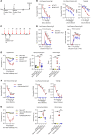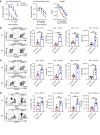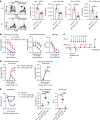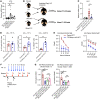T follicular regulatory cells and IL-10 promote food antigen-specific IgE
- PMID: 32255767
- PMCID: PMC7324176
- DOI: 10.1172/JCI132249
T follicular regulatory cells and IL-10 promote food antigen-specific IgE
Abstract
Food allergies are a major clinical problem and are driven by IgE antibodies (Abs) specific for food antigens (Ags). T follicular regulatory (Tfr) cells are a specialized subset of FOXP3+ T cells that modulate Ab responses. Here, we analyzed the role of Tfr cells in regulating Ag-specific IgE using a peanut-based food allergy model in mice. Peanut-specific IgE titers and anaphylaxis responses were significantly blunted in Tfr cell-deficient Foxp3-Cre Bcl6fl/fl mice. Loss of Tfr cells led to greatly increased nonspecific IgE levels, showing that Tfr cells have both helper and suppressor functions in IgE production in the germinal center (GC) that work together to facilitate the production of Ag-specific IgE. Foxp3-Cre Ptenfl/fl mice with augmented Tfr cell responses had markedly higher levels of peanut-specific IgE, revealing an active helper function by Tfr cells on Ag-specific IgE. The helper function of Tfr cells for IgE production involves IL-10, and the loss of IL-10 signaling by B cells led to a severely curtailed peanut-specific IgE response, decreased GCB cell survival, and loss of GC dark zone B cells after peanut sensitization. We thus reveal that Tfr cells have an unexpected helper role in promoting food allergy and may represent a target for drug development.
Keywords: Adaptive immunity; Allergy; Immunology.
Conflict of interest statement
Figures







Similar articles
-
T follicular regulatory cells in food allergy promote IgE via IL-4.JCI Insight. 2024 Oct 8;9(19):e171241. doi: 10.1172/jci.insight.171241. JCI Insight. 2024. PMID: 39377224 Free PMC article.
-
Regulation of the IgE response by T follicular regulatory cells.Allergol Int. 2025 Jan;74(1):20-24. doi: 10.1016/j.alit.2024.08.004. Epub 2024 Sep 3. Allergol Int. 2025. PMID: 39232918 Review.
-
Follicular regulatory T cells control humoral and allergic immunity by restraining early B cell responses.Nat Immunol. 2019 Oct;20(10):1360-1371. doi: 10.1038/s41590-019-0472-4. Epub 2019 Sep 2. Nat Immunol. 2019. PMID: 31477921 Free PMC article.
-
Follicular regulatory T cells repress cytokine production by follicular helper T cells and optimize IgG responses in mice.Eur J Immunol. 2016 May;46(5):1152-61. doi: 10.1002/eji.201546094. Epub 2016 Mar 11. Eur J Immunol. 2016. PMID: 26887860 Free PMC article.
-
Control of foreign Ag-specific Ab responses by Treg and Tfr.Immunol Rev. 2020 Jul;296(1):104-119. doi: 10.1111/imr.12888. Epub 2020 Jun 20. Immunol Rev. 2020. PMID: 32564426 Review.
Cited by
-
Assessing In Vivo T Cell-Dependent Antigen-Specific Antibody Responses.Methods Mol Biol. 2022;2380:165-174. doi: 10.1007/978-1-0716-1736-6_14. Methods Mol Biol. 2022. PMID: 34802130
-
IL-1β signaling modulates T follicular helper and regulatory cells in human lymphoid tissues.JCI Insight. 2025 May 20;10(12):e188724. doi: 10.1172/jci.insight.188724. eCollection 2025 Jun 23. JCI Insight. 2025. PMID: 40392614 Free PMC article.
-
Differentiation, functions, and roles of T follicular regulatory cells in autoimmune diseases.Inflamm Regen. 2021 May 3;41(1):14. doi: 10.1186/s41232-021-00164-9. Inflamm Regen. 2021. PMID: 33934711 Free PMC article. Review.
-
IL-33 signaling is dispensable for the IL-10-induced enhancement of mast cell responses during food allergy.Front Immunol. 2025 Jan 28;16:1526498. doi: 10.3389/fimmu.2025.1526498. eCollection 2025. Front Immunol. 2025. PMID: 39935481 Free PMC article.
-
The impact of HIV infection on the frequencies, function, spatial localization and heterogeneity of T follicular regulatory cells (TFRs) within human lymph nodes.BMC Immunol. 2022 Jul 1;23(1):34. doi: 10.1186/s12865-022-00508-1. BMC Immunol. 2022. PMID: 35778692 Free PMC article.
References
Publication types
MeSH terms
Substances
Grants and funding
LinkOut - more resources
Full Text Sources
Medical
Molecular Biology Databases
Miscellaneous

